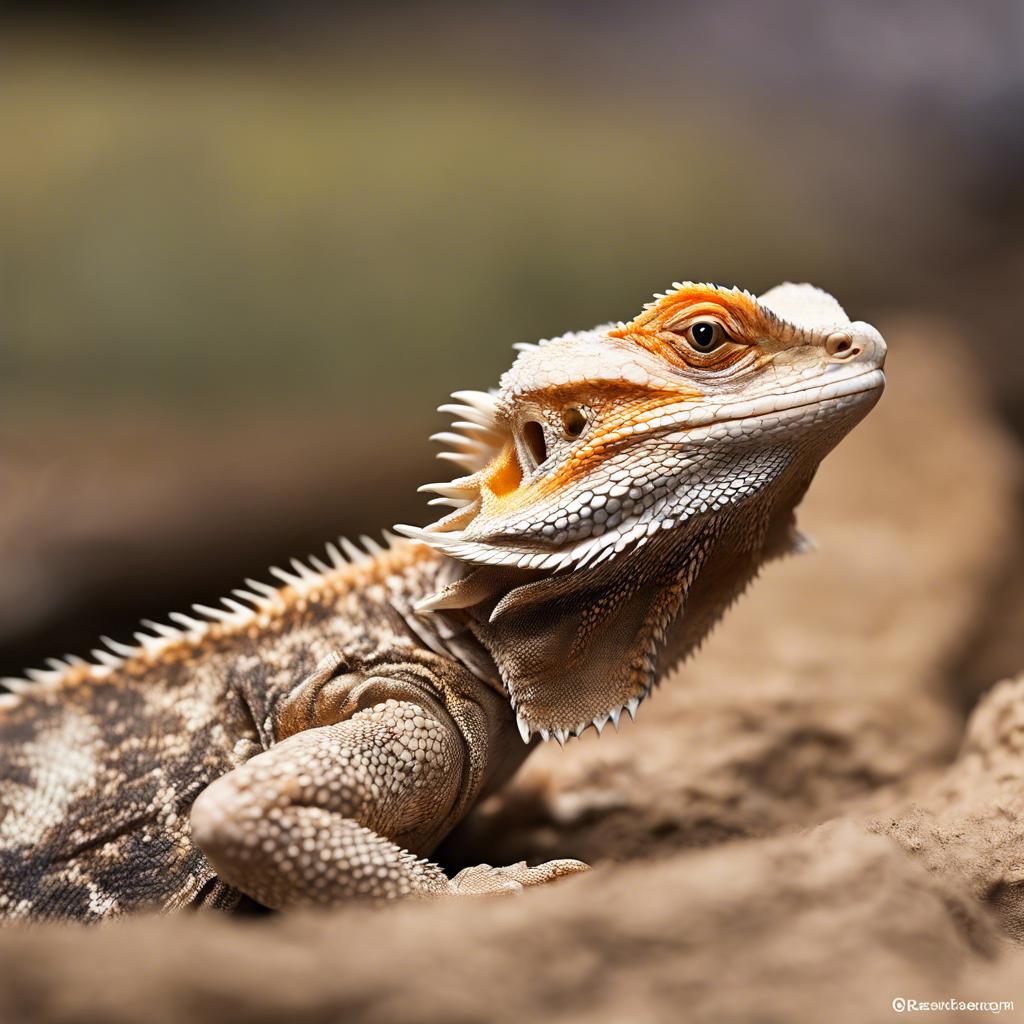Bearded dragons are popular reptile pets known for their unique appearance and docile nature. These reptiles are native to Australia and have become increasingly popular as pets due to their low maintenance requirements and friendly demeanor. However, like all pets, it is important for owners to understand the specific needs and health concerns of bearded dragons in order to provide them with the best care possible.
One crucial aspect of bearded dragon care is understanding their respiratory health. Respiratory issues can be common in these reptiles and can have serious consequences if not addressed promptly. In this article, we will explore the intricacies of bearded dragon respiration, debunk common myths, discuss the anatomy of their lungs, and provide tips for maintaining their respiratory health.
Key Takeaways
- Bearded dragons are popular pets that require proper respiratory care.
- Bearded dragons breathe through their nostrils and can't breathe on their backs.
- Bearded dragon lungs are divided into three lobes and are located in the chest cavity.
- Factors that affect bearded dragon breathing include temperature, humidity, and air quality.
- Signs of respiratory distress in bearded dragons include wheezing, coughing, and lethargy.
Understanding Bearded Dragon Respiration
Bearded dragons, like all reptiles, have a unique respiratory system that differs from mammals such as humans. While humans primarily use their diaphragm to breathe, bearded dragons rely on a combination of muscles in their throat and chest to facilitate respiration. These muscles work together to expand and contract the lungs, allowing the exchange of oxygen and carbon dioxide.
Unlike humans, bearded dragons do not have a diaphragm separating their chest cavity from their abdominal cavity. Instead, they rely on the movement of their throat muscles to create negative pressure in the chest cavity, drawing air into the lungs. This unique respiratory mechanism allows bearded dragons to breathe efficiently and effectively.
Can Bearded Dragons Breathe on Their Back?
There is a common myth that suggests bearded dragons can breathe on their back due to the presence of a small hole called a cloaca on their underside. However, this is not true. Bearded dragons cannot breathe on their back because their respiratory system is designed to work in an upright position.
The cloaca is a multi-purpose opening that serves as the exit point for waste, reproductive fluids, and the passage of eggs in female bearded dragons. It does not have any connection to the respiratory system. Therefore, it is important to handle bearded dragons with care and ensure they are in an upright position to avoid any respiratory distress.
The Anatomy of Bearded Dragon Lungs
To understand the importance of respiratory health in bearded dragons, it is essential to have a basic understanding of their lung anatomy. Bearded dragons have a pair of lungs located in their chest cavity, which are responsible for the exchange of oxygen and carbon dioxide.
The lungs of bearded dragons are relatively small compared to their body size. They consist of a network of tiny air sacs called alveoli, where the exchange of gases takes place. The structure of these lungs allows for efficient gas exchange, ensuring that bearded dragons receive an adequate supply of oxygen.
Factors That Affect Bearded Dragon Breathing
Several factors can affect the respiratory health of bearded dragons. Environmental factors such as temperature, humidity, and air quality play a significant role in their overall well-being.
Bearded dragons are ectothermic animals, meaning they rely on external sources of heat to regulate their body temperature. If the temperature in their environment is too low or too high, it can impact their ability to breathe properly. It is crucial to provide them with a suitable temperature gradient within their enclosure to allow for thermoregulation.
Humidity levels also play a role in bearded dragon respiration. These reptiles require a certain level of humidity to maintain healthy lung function. If the humidity is too low, it can lead to dehydration and respiratory issues. On the other hand, excessive humidity can create a breeding ground for bacteria and fungi, increasing the risk of respiratory infections.
Air quality is another important factor to consider. Bearded dragons are sensitive to airborne pollutants such as dust, chemicals, and smoke. Poor air quality can irritate their respiratory system and lead to respiratory distress. It is essential to keep their environment clean and free from any potential respiratory irritants.
In addition to environmental factors, certain health issues can also affect bearded dragon breathing. Respiratory infections, parasites, and stress can all contribute to respiratory distress in these reptiles. It is important to monitor their overall health and seek veterinary care if any concerning symptoms arise.
Signs of Respiratory Distress in Bearded Dragons

Recognizing the signs of respiratory distress in bearded dragons is crucial for early detection and prompt treatment. Some common symptoms to look out for include:
1. Open-mouth breathing: Bearded dragons may breathe with their mouth open, which is a sign of respiratory distress.
2. Wheezing or crackling sounds: If you hear any unusual sounds coming from your bearded dragon's chest while breathing, it may indicate a respiratory issue.
3. Rapid or labored breathing: If your bearded dragon is breathing rapidly or appears to be struggling to breathe, it is a cause for concern.
4. Nasal discharge: Any discharge from the nose, such as mucus or blood, should be evaluated by a veterinarian.
5. Lethargy or loss of appetite: Respiratory issues can cause a decrease in energy levels and appetite in bearded dragons.
It is important to note that these symptoms can also be indicative of other health issues, so it is essential to consult with a reptile veterinarian for an accurate diagnosis.
How to Care for a Bearded Dragon's Respiratory Health
Maintaining a healthy environment is key to ensuring the respiratory health of your bearded dragon. Here are some tips to help you provide optimal care:
1. Temperature regulation: Create a temperature gradient within the enclosure, allowing your bearded dragon to move between warmer and cooler areas as needed.
2. Humidity control: Monitor humidity levels and provide a suitable range for your bearded dragon's specific needs. This can be achieved through the use of a hygrometer and misting the enclosure with water if necessary.
3. Cleanliness: Regularly clean the enclosure to remove any dust, debris, or potential respiratory irritants. Use a reptile-safe disinfectant to ensure a clean and hygienic environment.
4. Proper ventilation: Ensure that the enclosure has adequate ventilation to prevent the buildup of stagnant air and maintain good air quality.
5. Avoid exposure to smoke and chemicals: Bearded dragons are sensitive to airborne pollutants, so it is important to keep them away from sources of smoke and chemicals.
Tips for Maintaining Healthy Air Quality for Bearded Dragons
Maintaining healthy air quality is crucial for the respiratory health of bearded dragons. Here are some tips to improve air quality in their environment:
1. Use an air purifier: Consider using an air purifier with a HEPA filter to remove airborne particles and improve air quality.
2. Avoid aerosol sprays: Avoid using aerosol sprays or any products that release chemicals into the air, as they can be harmful to your bearded dragon's respiratory system.
3. Provide proper ventilation: Ensure that the enclosure has adequate airflow by using vents or fans to circulate fresh air.
4. Dust control: Bearded dragons are sensitive to dust, so it is important to minimize dust in their environment. Avoid using dusty substrates and regularly clean the enclosure to remove any accumulated dust.
5. Avoid smoking around your bearded dragon: Smoking can have detrimental effects on your pet's respiratory health, so it is important to avoid smoking in their presence.
Common Respiratory Problems in Bearded Dragons
Despite proper care, bearded dragons can still develop respiratory issues. Some common respiratory problems in bearded dragons include:
1. Respiratory infections: Bacterial, viral, or fungal infections can affect the respiratory system of bearded dragons and cause symptoms such as wheezing, coughing, and nasal discharge.
2. Parasitic infections: Parasites such as lungworms can infect the respiratory system of bearded dragons and lead to respiratory distress.
3. Pneumonia: Bearded dragons can develop pneumonia, which is an inflammation of the lungs that can be caused by bacterial or fungal infections.
4. Respiratory allergies: Some bearded dragons may develop allergies to certain substances in their environment, leading to respiratory symptoms.
Treatment for these respiratory problems typically involves a combination of medication, supportive care, and environmental adjustments. It is important to consult with a reptile veterinarian for an accurate diagnosis and appropriate treatment plan.
When to Seek Veterinary Care for Your Bearded Dragon's Respiratory Issues
If you notice any signs of respiratory distress in your bearded dragon, it is important to seek veterinary care as soon as possible. Respiratory issues can quickly escalate and become life-threatening if left untreated.
A reptile veterinarian will be able to perform a thorough examination, conduct diagnostic tests if necessary, and provide appropriate treatment for your bearded dragon's respiratory issues. They will also be able to offer guidance on how to maintain optimal respiratory health for your pet.
In conclusion, understanding and maintaining the respiratory health of bearded dragons is crucial for their overall well-being. Bearded dragons have a unique respiratory system that differs from mammals, and it is important to provide them with a suitable environment that promotes healthy respiration.
Factors such as temperature, humidity, air quality, and overall health can all impact the respiratory health of bearded dragons. It is important to monitor their environment, recognize the signs of respiratory distress, and seek veterinary care when necessary.
By taking proper care of your bearded dragon's respiratory health, you can ensure that they live a long and healthy life as your beloved pet.
If you're curious about whether bearded dragons can breathe on their back, you'll find some interesting insights in this article from Reptile Wizard. They explore the unique respiratory system of bearded dragons and discuss how they breathe through their lungs and air sacs. To learn more about this fascinating topic, check out the article here.
FAQs
What is a bearded dragon?
A bearded dragon is a type of lizard that is native to Australia. They are popular pets due to their docile nature and unique appearance.
How do bearded dragons breathe?
Bearded dragons breathe through their nostrils, located on the top of their snout. They do not have the ability to breathe through their skin or back.
Can bearded dragons breathe on their back?
No, bearded dragons cannot breathe on their back. They do not have lungs or respiratory structures on their back, and their breathing is solely dependent on their nostrils.
Why do people ask if bearded dragons can breathe on their back?
There is a common misconception that some animals, such as turtles, can breathe through their skin or back. This is not true for bearded dragons, and the question may arise due to confusion or misinformation.
What should I do if I suspect my bearded dragon is having trouble breathing?
If you notice any signs of respiratory distress in your bearded dragon, such as wheezing or labored breathing, it is important to seek veterinary care immediately. Respiratory issues can be serious and potentially life-threatening for reptiles.

